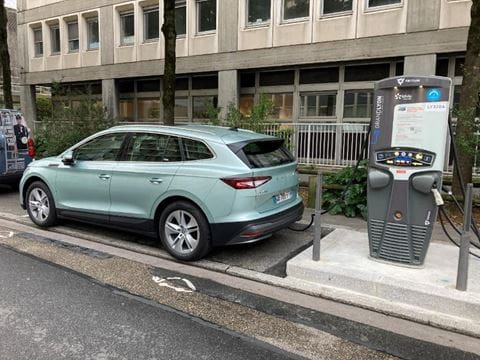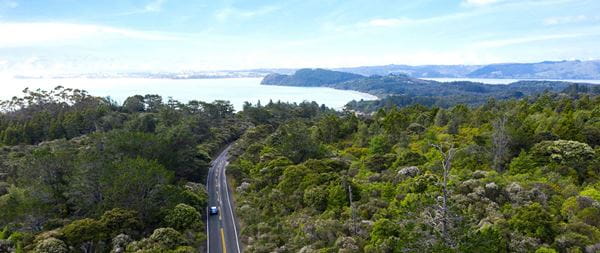
Driving from Lyon to Catalonia in an electric car
To make their way to the LeasePlan 2022 seminar venue just north of Barcelona, a group of 4 LeasePlanners took the initiative of taking the trip in an electric car. They have been able to provide us with this great feedback from their experience.
Departure: Lyon (France) at 9:15 am
Arrival: Santa Susanna (Catalonia – Spain) at 4:45 pm
Journey: 4 people and 4 suitcases travelled 596km in 6 hours and 24 minutes

Vehicle: Skoda ENYAQ IV 80 (2022)
- Vehicle charging power: 135 kW
- Fast charging power: 135 kW
- Net battery capacity: 77kWh
- Range announced at the start at 100%: 434 km (with air conditioning) / 560 km (without air conditioning)
Driving to Catalonia
Stops: 2 (only 1 actually needed) - at noon (50 minutes) and at 3 pm (20 minutes) Average speed: 94 km/h Average fuel consumption: 19.3 kWh/100 km
We planned the trip in advance using the A Better Route Planner (ABRP) app as well as Shell Recharge (to ensure compatibility with our charging card). We programmed the vehicle’s GPS to propose charging stations to compare with what was suggested in the apps.
We decided to not to worry about the following constraints:
- Filled trunk
- Air conditioning activated (with heat pump)
- Stops at the desired times (lunch + coffee break)
- French motorway at 130 km/h and Spanish motorway at 120 km/h
Departure at 9:15 am: Lyon (Part Dieu district – LeasePlan France Lyon)
The trip started with an additional load at the meeting place at 9am (the time that each of us meets). Bad surprise when arriving: the IZIVIA network terminal (50 kWh) next to the Part Dieu station (Lyon) turned out to be "inactive". Support responds after 5 minutes and reports that they were safe. Indeed, the emergency stop button had been pressed by a user (or a joker frustrated with not finding gas at the station?!).
- Charged from 98% to 100% in 6 minutes (2.3 kWh: €2.35)
The trip began with an expected range of 434 km. The car was so silent that the three passengers could easily make phone calls, answer emails, chat and even attend a Teams meeting! The car had plenty of leg room too. With all 4 of us being over 1 metre 80, we found the car very comfortable for the entire trip.
Charging stop 3: Coffee break and a short charge at 3 pm
Around 3 pm, when we were close to the border, we decided to stop for a coffee break, charge a little and swap drivers. We preferred to charge at the French terminals to benefit from the most carbon free energy mix. The French electricity operator, RTE, has an app and it told us that the energy being produced at that moment was 65% nuclear and 14% solar.
- Charge at the Catalan Village Area for 20 minutes
- Range on arrival: 163 km (43%)
- Range at departure: 315 km (80%)
- Cost of fast charging: €21 for 152 km of range (€0.69 per kWh)
The trip was made on a Wednesday and all charging areas had a terminal available. This is a point worth emphasising because we have noticed that the charging stations in town centres often have petrol or diesel powered cars parked in the spaces, or even electric ones that are not even charging!
Arrival at 16:45: Santa Susanna (Catalonia – Spain)
The entire trip was very comfortable and there were a lot of charging possibilities as we were travelling on major roads. Indeed, even if we could not access the planned charging stations in the Tavel North Area, other solutions could be found easily. Finally, a pleasant surprise on arrival, the hotel had brand new charging stations (not indicated on the ChargeMap application).. This allowed us to charge the battery to 100% for the return journey.
During the ride, we never felt like we were wasting time or waiting around for the car to charge. The comfort of fast charging stations is ideal; on the other hand, the price makes it more suitable as an occasional solution. Bonus: We arrived 1 hour before our colleagues who were traveling by plane. While they were waiting in long lines at the airport we were able to attend our meetings in the car and enjoy lunch in the sun on a terrace!
Our 5 tips:
- 1.Don't necessarily select Eco mode because on the motorway you can accelerate faster to reach cruising speed faster (which consumes less electricity)
- 2.Use the Chargerprice app to compare your charging prices (if you have multiple cards for example)
- 3.When using A Better Route Planner (ABRP), create an account to record all important vehicle and trip information (vehicle age, battery capacity, route settings...)
- 4.Use the Shell Recharge, Izivia or ChargeMap application to see whether the charging stations are busy
- 5.Indicate how long you intend to stay at the charging station (as a courtesy to other EV drivers):. You can do this via the ChargeMap app and/or with the LeasePlan Happy Charger disc.








